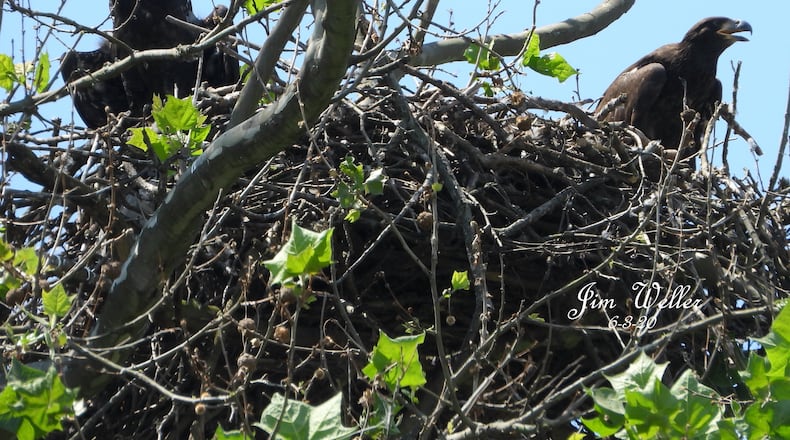In keeping with naming guidelines from past years, these non-gender specific, Dayton history and aviation connected names continue to reflect the eagles' choice of nesting directly above Wright Hall, which houses the original 1905 Wright Flyer III, Weller explained.
“Prop and Rudder are now part of Dayton's ongoing history joining Orv and Willa's previous eaglets, Soar & Flyer (2018) and Aero & Prairie (2019),” he said. “We are excited to watch these current eaglets as they get ready to fledge from the nest in the next 8-20 days!”
Carillon is closed, but Weller said the eaglets’ first flights should be visible from outside the park as each eaglet has a wingspan of 6 feet or more.
ORIGINAL REPORT: May 10, 2020: Carillon Historical Park’s bald eaglets part of ‘dramatic’ Ohio comeback
Two young eaglets, the offspring of Carillon Historical Park’s resident bald eagles, are part of an Ohio success story.
“The babies are doing fantastically well,” said Jim Weller, founder of the Eastwood Eagle Watchers. “Mom and dad are taking really good care of them.”
The babies hatched March 24, and are the third generation of offspring for Orv and Willa, Dayton’s popular pair-bonded eagle couple.
The young eagles are now a foot tall and covered in a body fuzz Weller calls a “grey flannel suit.” Feathers have begun sprouting on their tail and wing tips and will soon sprout on the back of their necks and top of their heads.
“They spend all day looking over the nest like bored teenagers,” Weller said.
The Dayton eaglets aren’t the only ones thriving.
This spring, the Ohio Department of Natural Resources conducted a census of bald eagle nests across the state, the first in eight years.
There were 707 reported bald eagle nests, an increase of 152% from the 2012 census that reported 281 nests in the state, according to the ODNR.
Bald eagles, the national symbol, were in danger of extinction in the United States during the 1960s, and there were only two known nests in Ohio, Weller said.
“That’s the dramatic thing about this comeback,” Weller said. “It’s unprecedented that the population would rebound that quickly.”
PHOTOS: Let’s celebrate the Class of 2020, Part 9
As the Carillon Historical Park eaglets grow, they will become more independent and will begin to eat on their own in the nest. And they will eventually be covered in feathers.
“When they start exercising those big wings, it will look like chaos,” Weller said.
“If you can imagine two teenagers in an eight-foot cubicle with push brooms coming out of either sleeve and swirling around together you’ll get the image of what this looks like.”
Carillon Historical Park is temporarily closed during the coronavirus pandemic, so Weller and other eagle watchers keep an eye on the nest with telephoto lenses from Carillon Boulevard.
By late June, Weller expects the pair to begin practice flights.
The eaglets are still unnamed at this point, but are expected to be given names soon.
The eagles born last year were named Aero and Prairie, a nod to the Wright brothers’ aeroplane and Huffman Prairie Flying Field, the cow pasture where Orville & Wilbur flew the 1905 Wright Flyer III.
About the Author



